Antique Desire
A Recent Find: A Pair of Carlton Ware Armand Lustre Ware Vases
by Kelly Keating on 11/26/10
Recently, I have been working with a wonderful designer in Madison, New Jersey who loves to use antiques in designing her clients' homes. She asked me to find a pair of vases for a client's living room mantle. The pair had to be substantial in size, complement the rooms color scheme of pale blue and rusty red and have a slight Asian feel. With this brief I found a gorgeous pair of ginger jars by the English manufacturer Carlton Ware dating to circa 1915-1920 in Tennessee of all places.
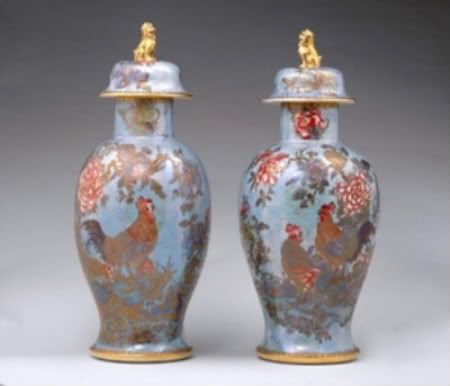
The vases feature a complementary, yet different design of hand-painted cockerels or roosters in underglaze enamels of rusty reds and navy amongst rusty red peonies set against a pale, mottled lustre blue ground. The entire motif is superbly highlighted with an overglaze metallic gold which was probably applied using a transferware process. This color scheme was a perfect match to the drapery treatments of the room. The vases on the mantle brought all the wonderful color of the drapes to the focal point of the room.
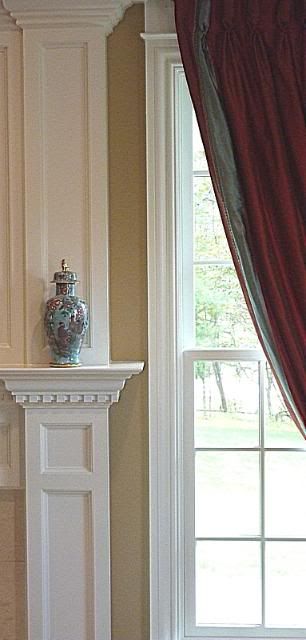
The cockerels and the peonies reminiscent of motifs in Japanese art impart the slightly Asian feel that the designer wanted to highlight in the room. This Asian feel is further enhanced by the finials of the ginger jars which are gilded foo dogs. In Asian culture, foo dogs serve as guardians against evil spirits at the entrances of homes and temples. They are a subtle and sophisticated addition to the vases. The cockerel motif, color scheme and foo dog finials firmly place this pair of Carlton Ware vases in the long tradition of European decorative arts that have been influenced by the arts of China and Japan.
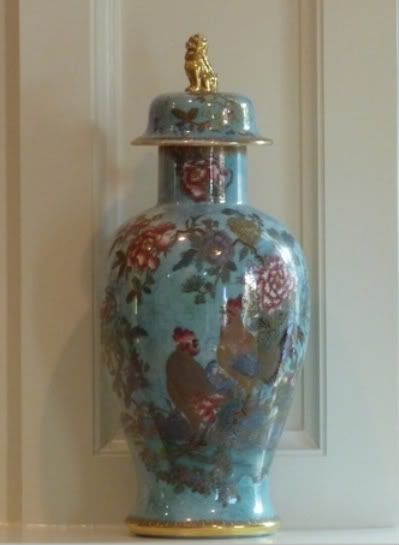
Carlton Ware was founded in 1890 and based in Stoke-on-Trent, England; The Carlton Ware trademark was introduced in 1894. The pair of cockerel vases I recently found were sold under Carlton Ware's separate high-end Armand line which began production circa 1915-1920. The vases are a true high fired lustreware with a pottery body more like china than heavy earthenware and were expensive at the time of their production. The backstamp shows 2 fish in water encircled by the name of the line.
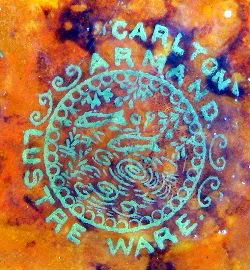
In the 1920's Carlton Ware introduced a new mode of production which combined decals applied to high glaze bodies with some hand-painting and gilt transfer. This process was in a sense a cheaper version of the expensive Armand line which did not use decals and was all hand-painted. This new process featured Asian inspired patterns such as New Mikado and Chinoiserie as well as a range of Tutankhamen inspired ware. The tomb of the pharaoh was discovered in 1922 by Howard Carter; the objects found in the tomb inspired many branches of the decorative arts. There was also a pattern called Persian that was inspired by the arts of the Near East. Here is a later New Mikado vase dated circa 1950:
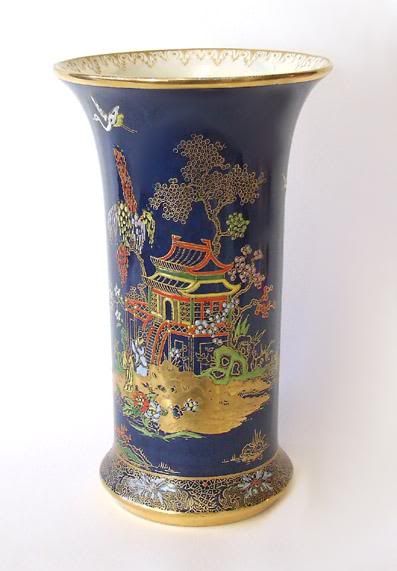
Contact me at [email protected] if you would like me to find you a gorgeous Carlton Ware item!
Collecting Antique Silver: A Celestial Teaspoon by Wood & Hughes
by Kelly Keating on 11/05/10
Welcome to Antique Desire from The Antique Flaneur, a blog which provides indepth discussion and information about antiques and vintage items as well as just simply expressing the joy of collecting antiques to decorate and adorn your home.
Over the last several years, I have become an avid collector of late 19th century sterling silver and silverplate flatware as well as holloware. Particularly, I am interested in pieces (and this is no surprise) which show the influence of Japanese and Chinese art in form as well as content. But, I am also drawn to English Edwardian silver and to more classical flatware forms especially those which have a shell motif.

Pictured here is a humble sterling teaspoon in a pattern called Celestial by the New York City silver company, Wood & Hughes. This multi-motif pattern was introduced in 1870. As a multi-motif pattern, each utensil has a different yet complementary design on the handle of the spoon
The Celestial teaspoon handle depicts a robed Asian figure standing on a balcony of an architectural structure with a vaguely Eastern aesthetic. The building with its curved and crenellated roof suggests a pagoda. Behind the figure stands a column which is perhaps part of an open arcade, another feature sometimes seen in Chinese architecture.
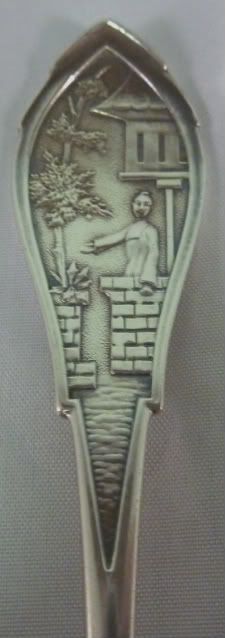
The male figure with his top knot and wide sleeved robe extends his right arm in a gesture of welcome. Or perhaps his gesture is meant to indicate the plant and tree which stand on another balcony on the left side of the spoon handle. The tree is reminiscent of pine trees in Chinese landscape painting.
The most intriguing detail of this intricate and beautiful spoon is the triangular area below the balconies as the handle of the spoon tapers into the shaft. The texture of the silver suggests at first water or more likely a depiction of clouds as if the architecture within the spoon is not grounded but floating in the sky.
This rendering of clouds is further emphasized by the pattern name Celestial which means heaven, divinity, ethereal, otherworldly. In addition, the pattern name almost certainly refers to The Celestial Empire, an old name for China. The Emperor of China was known as The Son of Heaven.
All of these connotations of the Orient adhere to the spoon. The spoon's fantastical Chinese architecture suspended above the clouds and its depiction of the Other implies something not of this world or at least not of the original buyer's world of the late 19th century. Perhaps this spoon excited the purchaser's imagination about the East, about The Celestial Empire, about the Other. The buyer sought to bring this animation to their dining table, to their dining experience and to their life.
Yet, my love of this spoon goes beyond just fantasies about a mythical Orient. It is also about nostalgia, a connection to the past. Someone designed this spoon. Someone made it. Someone bought this spoon. Someone loved it.
With this teaspoon, someone wanted to be fashionable or wanted to show off their distinctive taste to their friends and the world. Someone cared for it, polished it, used it to stir cream and sugar into their tea until their death. It was passed on to children or it was sold or it languished in a drawer until a silver dealer found it and made it available for me to buy.
Underlined by its aesthetic design, the satisfyingly mellow glow of its silver and the subtle traces of use and polish, this simple spoon has the patina of history. It has survived. It embodies all the feelings, thoughts, joys and disappointments of those who designed it, created it, stirred it and loved it.
When I admire this spoon, when I use this spoon, when I see it displayed on my sideboard, I am reminded of quote by Susan Sontag. She states: "Fewer and fewer Americans possess objects that have patina, old furniture, grandparents' pots and pans, the used things, warm with generations of human touch, essential to the human landscape. Instead, we have paper phantoms, transistorized landscapes. A featherweight portable museum."
This humble teaspoon adorns my landscape. It connects me to the past. Beyond its beauty or because of it, it stands against the disposable nature of modern life and the continual effacement of the body by technology. Its physical concreteness and emotional evocation give me great pleasure. It's just fabulous.
